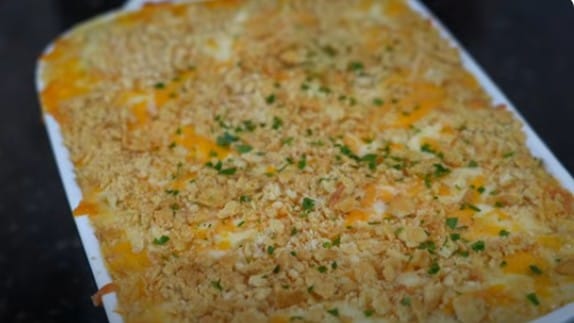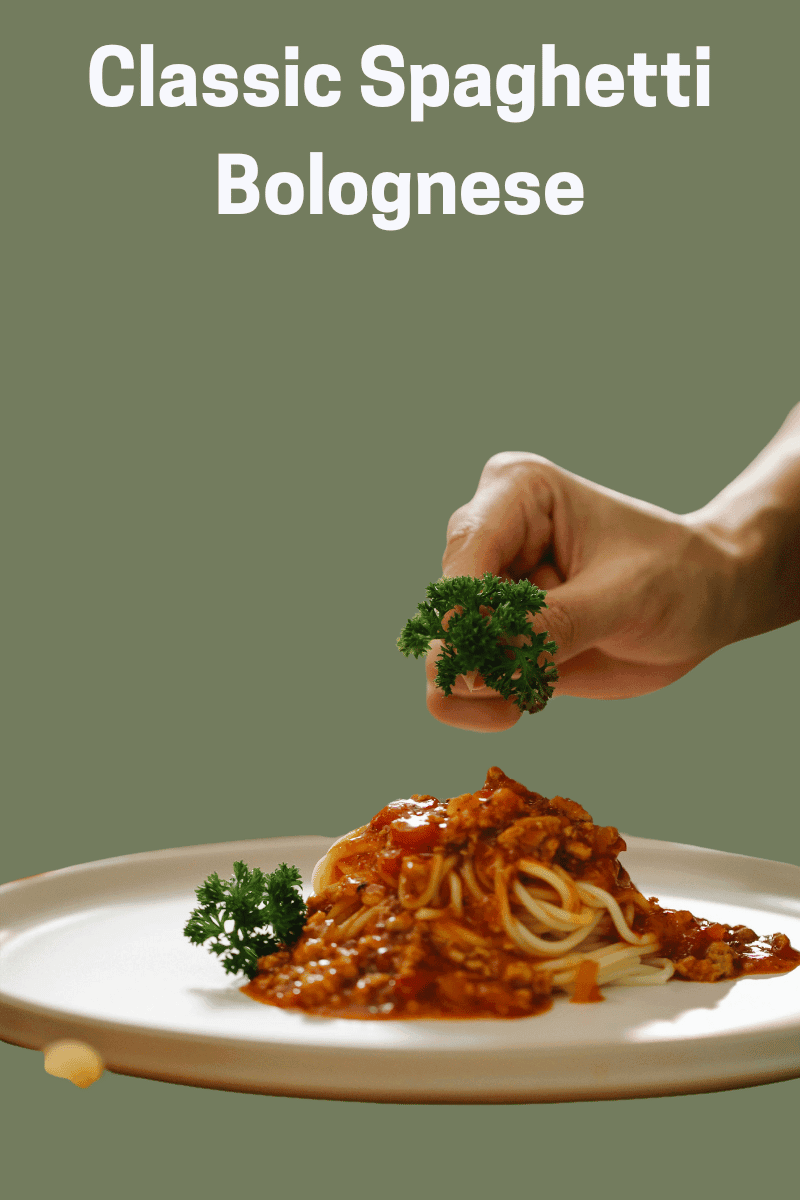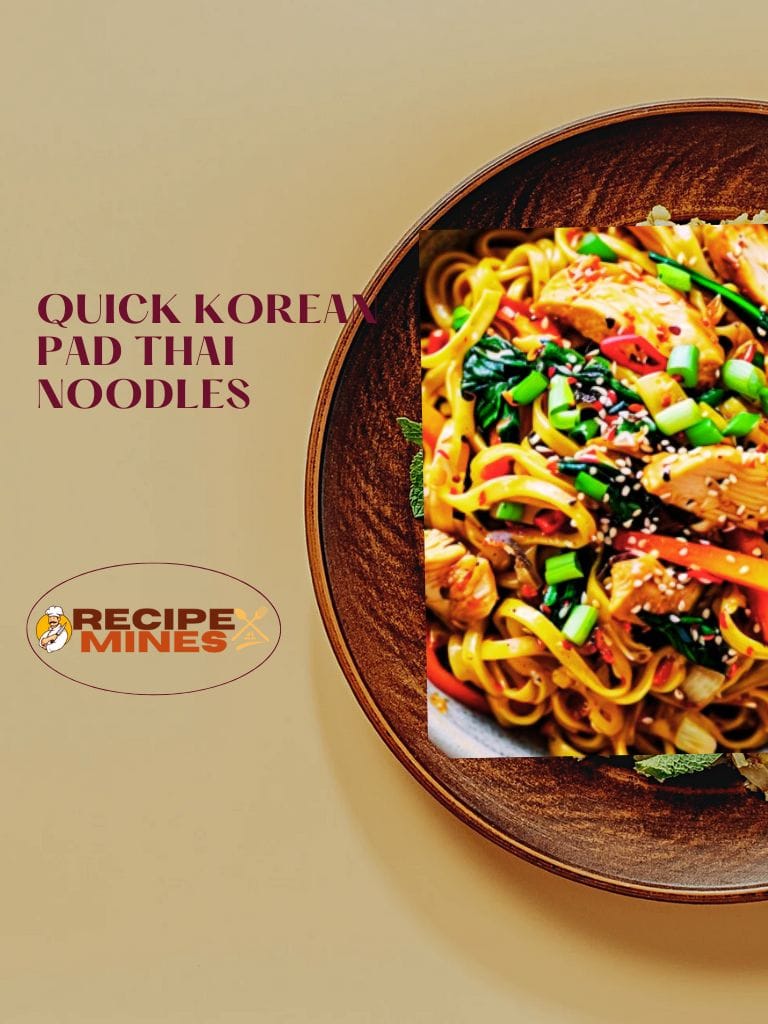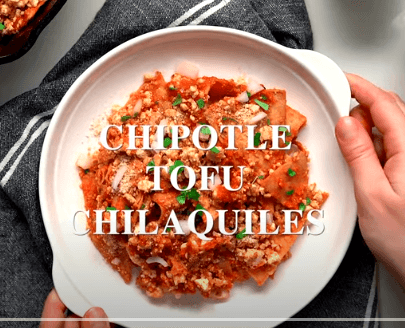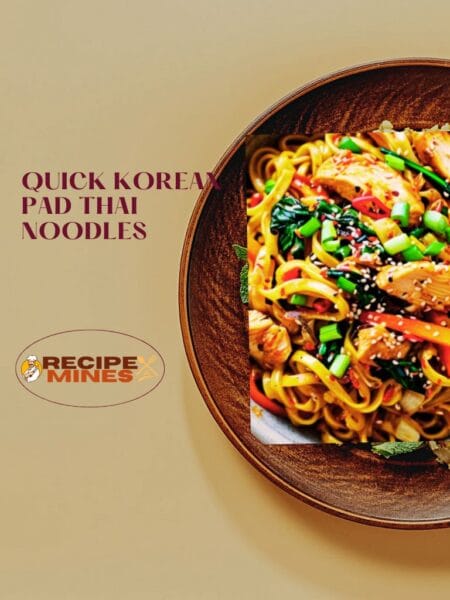Chicken Biryani Recipe – Rich, Spicy, and Irresistible
If you’re looking for a tasty Chicken Biryani Recipe filled with aromatic spices, juicy chicken, and delicious basmati rice, this Chicken Biryani is just what you need. Chicken Biryani — loved from India to around the world — isn’t just a food dish; it is a spectacular feeling and taste that you will never forget. Once you eat Chicken Biryani, you will want it again and again.
This Chicken Biryani Recipe has elements of the traditional Hyderabadi chicken biryani dum cooking method, with easy cooking steps where even a beginner would eventually become a master. Whether you are preparing for a festive occasion or treating yourself on a weekend satisfying meal, this easy chicken biryani recipe has the full joy of taste.
What makes this recipe special is the “dum” method- a method of slow cooking, in which marinated chicken is placed at the bottom of a vessel, then semi-cooked rice is placed on top, saffron milk, mint and fried onions placed on top, and finally the lid is sealed and placed on low heat – resulting in beautiful layers of flavors and textures, referred as chicken biryani dum hyderabadi style.
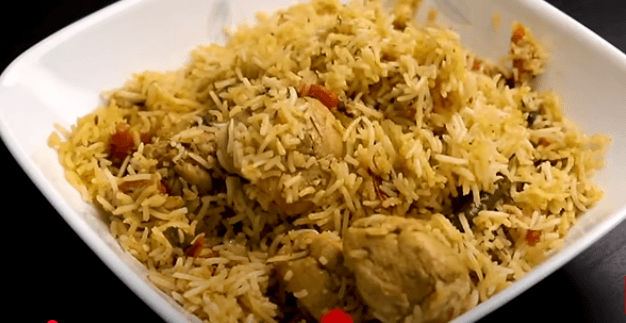
The Aromatic Alchemy: Unraveling the Magic of Biryani
There are but a few dishes in the world that have the breathtaking universal romance, provoke belligerent disagreements, and cause explosive sensory excitement like Biryani. It is more than a rice dish; it is an orchestra of flavors, a layered story of history and civilization, an experience that is more than just food. It is the absolute pinnacle of sub-continent culinary arts, a fragrant myth served hot from a handi (pot), and a guaranteed mealtime utter bliss.
A Journey Through Time and Taste
The history of Biryani is just as complicated as the dish itself. While many believe Biryani takes its origin in Persia, Middle Eastern cultures have twists of their own, such as the word “birinj” for rice; another possibility is “biryan,” which means to fry or roast. Biryani traveled to the Indian subcontinent with the Mughal emperors, as well as trade and military commerce potentially fostered the expansion of Biryani, before it was modified beyond recognition with local products and culinary customs. No matter whether it was the royal kitchens of Awadh (Lucknow) and the Nizams of Hyderabad, the busy ports of Kolkata, or coastal eating in the backwaters of Kerala, Biryani had morphed and set its roots in some form or another into the fabric of the region.
The Essence of the Elixir: Layers of Perfection
Biryani is at its core a deceptively simple dish: rice and meat (or vegetables) cooked together in a melange of spices. But within its simplicity lurks a world of complexity:
- The Rice: Long-grained, fragrant, Basmati rice reigns supreme. It must be parboiled, with the long grains separate but soaking up the spices and flavors.
- The Meat/Protein: Traditionally, Biryani has been made with mutton or chicken. The meat is marinated in yogurt and spices to tenderize it and flavor it more. But, Biryani has a lot of versatility; succulent beef (in some regions), melt-in-the-mouth lamb, fresh fish and prawns (in coastal variations like Malabar Biryani), flavorful vegetables, and maybe boiled eggs or paneer.
- The Aromatics and Spices: This is where the magic is made. Saffron (kesar) adds a golden hue and heady aroma. The big hitters to start building your warm notes files are cardamom (elaichi), cloves (laung), cinnamon (dalchini), bay leaves (tej patta), star anise, and even mace (javitri). The foundational elements also include ginger, garlic, green chilies, and some fresh herbs, mint (pudina), and coriander (dhaniya) for freshness and vibrancy. The fried onions (birista) contribute essential sweetness and texture.
- The Technique – Dum Pukht: The real essence of a typical Biryani lies in the process of cooking. Dum Pukht is translated as “choke-breath” cooking. Semi-cooked rice is layered on marinated meat (and its delicious gravy or masala), and sealed in a thick-bottomed pot (handi or deg) with dough or a lid that fits tightly. After being placed on the fireplace, the process cooks slowly with a low flame, and the ingredients slowly steam with their juices. This slow process of vaporization allows the meat to mellow, the rice to absorb the perfumed essence, and the spices to intermingle and blend. When the seal is lifted, and a cloud of aromatic steam rises in a cascade, it is pure theatre.
A Kaleidoscope of Regional Delights
Biryani isn’t monolithic; it’s a vibrant family of distinct regional personalities:
- Hyderabadi Biryani: Undoubtedly the most famous variety. Hyderabadi Biryani also has bold flavors, plentiful amounts of chilies, saffron, and it has different styles. There is the “Kacchi” style (raw meat with raw rice) and the “Pakki” style (cooked meat and rice). This style has fragrant kewra water.
- Lucknowi (Awadhi) Biryani: Hyderabadi Biryani it is understated, touted for its delicately spiced flavors, a focus on aromatic spices rather than heat, and a liquid yogurt gravy prior to layering for a “Pakki” version.
- Kolkata Biryani: A unique legacy, perhaps, with noticeable sweetness from aloo (potatoes), and courtly floral tastes. This type is often accompanied by boiled eggs, and it tends to be a lighter on spices than the southern versions. The addition of the potato is legendary (and debated)!
- Thalassery (Malabar) Biryani: From Kerala, this version uses fragrant, small-grained Khaima/Jeerakasala rice vs. Basmati. Distinct uses of Malabar spices, fried onions, cashews, raisins, and often, chicken or mutton. Less greasy and has a unique texture.
- Sindhi Biryani: Famous as the tangiest of the bunch, which is often created with dried plums (aloobukhara), yogurt, and its red coloration. Potatoes are also common.
- Memoni Biryani: Much like Sindhi, though often spicier, derivatives from the Memon community with bold flavors and darker.
- Ambur/Vaniyambadi Biryani (Tamil Nadu): Short-grained Seeraga Samba rice is the main ingredient. Recognized for its distinct mix of spices (including stone flower/lichen – kalpasi) and a special, slightly sour note that is often from curd or lemon.
Beyond the Plate: A Cultural Icon
Biryani is not just food; it is an occasion. At weddings, Eid, Diwali, and birthdays, it assumes the key role as the lead star of the celebratory gathering. It provides a foundation for families to gather and talk, while digging into the layers of baked rice and meat. It engenders friendly (and sometimes fierce) competition about which city or style of biryani is better than which. It inspires heartwarming memories while transporting people back to kitchens or special occasions that remind them of their childhood.
The Perfect Accompaniment
Biryani is not just food; it is a celebration. At weddings, Eid, Diwali, and birthdays, it takes center stage as the inevitable lead star of the celebratory gathering. It provides a platform for families to convene and converse while digging into the layers of baked rice and meat. It fosters friendly (and sometimes heated) competition about which city or style of biryani is superior, inspiring an otherwise innocuous yet passionate debate. It evokes nostalgia while whisking people back to kitchens or to momentous occasions that remind them of their childhood.
The Enduring Allure
Biryani is special because of its magic. Biryani takes natural, daily ingredients and, with time, technique, and a clear sense of flavor balance, creates magic. It’s a dish that commands respect: for its ancestry, its complexity, and for the ability to understand how to properly make Biryani. There is a journey in each bite: the fluffy fragrant rice, the textured tender meat, the kick of a caramelized onion or a refreshing burst of mint, all held together by slow cooking and saffron.
So when the pot of Biryani arrives in front of you, stay a moment! Breathe in the sweet, intoxicating aroma of all the layers that comprise your meal. Recognize the layers, historical and physical. And then dig in. You’re not just consuming a meal; you are participating in a tradition that spans centuries, an epicurean piece of art, and a demonstration of the enduring power of layers of magic. Biryani is not just cooked; Biryani is celebrated, crafted, and irreplaceably and deeply loved.
Chicken Biryani 2025
Description
Introduction to Chicken Biryani
Ah, Chicken Biryani — a dish that brings people together. Whether it’s a family dinner, a festive celebration, or a weekend treat, biryani holds a special place in Indian hearts and kitchens.
The Rich History of Biryani
Originally brought to India by Persian travelers and refined by Mughal emperors, biryani has evolved into countless regional styles across the country. It's not just a meal, it’s a celebration of flavor and culture.
What Makes Indian Biryani Special?
It’s the spice blend. The slow cooking. The layering of flavors. From saffron-infused rice to juicy marinated chicken, every bite is a burst of tradition and taste
Ingredients for Chicken Biryani
For Cooking Chicken
For Cooking Rice:
Preparation
- Clean & wash the chicken pieces. Drain the water or pat dry.
- Slice the onions and tomatoes. Slit 6 green chillies
- Chop 1 cup coriander leaves and 1 cup mint
- Whisk the yogurt and set aside
- Wash & soak the Basmati Rice for 30 mins.
Process
To cook the Chicken:
- Heat 6 tbsp oil in a heavy bottom pan and add the sliced onions.
- Fry on high heat for around 12 mins till the onions are light brown.
- Add the ginger garlic paste and fry on low heat for 2 mins.
- Now add the chicken pieces, mix and fry on high heat for 2-3 mins.
- Add the ready made Biryani Masala, mix and fry on medium heat for 3 mins after adding a splash of water.
- Readymade Biryani Masala usually contains salt, hence salt is not added while cooking the chicken in this recipe. Do check if the biryani masala you are using has salt in it.
- Now add the sliced tomatoes, mix it well and cook on medium to low heat for 4-5 mins till soft.
- Keep the heat on low and add the whisked curd/yogurt. Give a mix and then add the chopped coriander and mint leaves.
- Cook on low heat for 2 mins till oil separates.
- Cover & cook on low heat for around 20-25 mins till chicken is tender. Remove lid after 10 mins, give a mix and close the lid again.
- Dry up any excess water to get a thick gravy.
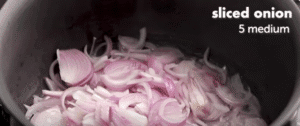
Chicken Biryani 
Chicken Biryani 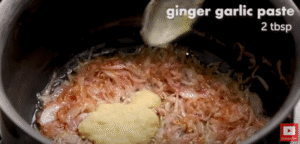


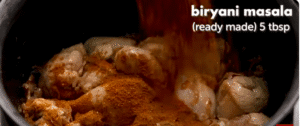


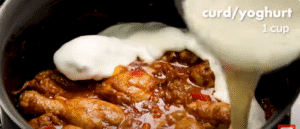
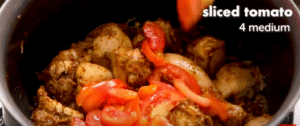
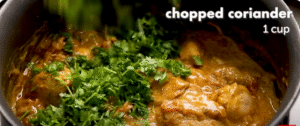
Chicken Biryani
To cook the Rice
- Take one more heavy bottom pan & add around 2.5 litres of water. Place it on high heat.
- You may include the water in which rice was soaked in this 2.5 litres for enhanced flavour & taste.
- Once the water starts to boil or bubble, add Shah Jeera - 1/2 tsp, Green cardamom 4, Cloves - 4, Cinnamon 2 pieces and Salt- 2 1/2 tablespoon (two and half tablespoon)
- Stir it well to dissolve the salt completely . The water must be very salty.
- Once the water starts boiling, add the strained basmati rice & stir it well.
- Continue to boil it on high heat, stirring few times very gently to not break the rice.
- After 8-9 minutes when the basmati rice is almost done (90%) remove it from heat and strain the water. Set it aside.

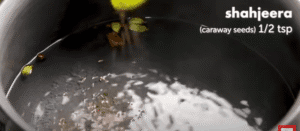
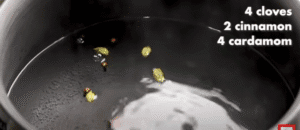


Chicken Biryani 



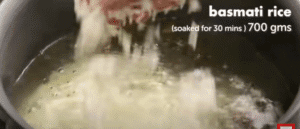

Chicken Biryani
Layering the rice and cooked chicken
- Take a heavy bottom pan and spread half the cooked rice as the 1st layer.
- Now spread the cooked chicken with gravy on top of the rice uniformly as shown in the video.
- Next, spread the balance rice as the top layer.
- Sprinkle some mint leaves on top of the rice. Close the lid and cook on low heat for 7-8 mins.
- Allow it to rest for around 20 mins.
- Once you open the lid, mix the chicken and rice evenly.
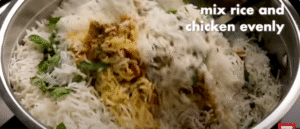

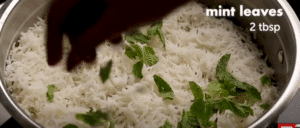
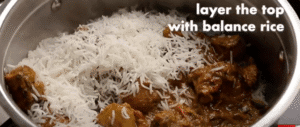
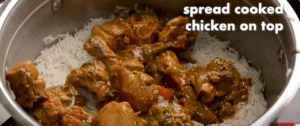

Nutrition Facts
Servings 6
- Amount Per Serving
- Calories 1902.72kcal
- % Daily Value *
- Total Fat 30.04g47%
- Saturated Fat 8.65g44%
- Trans Fat 0.16g
- Cholesterol 131.37mg44%
- Sodium 1053.04mg44%
- Potassium 1505.72mg44%
- Total Carbohydrate 333.12g112%
- Dietary Fiber 9.33g38%
- Sugars 8.62g
- Protein 66.15g133%
- Vitamin A 301.57 IU
- Vitamin C 139.35 mg
- Calcium 271.77 mg
- Iron 16.02 mg
- Vitamin D 0.37 IU
- Vitamin E 1.91 IU
- Vitamin K 70.72 mcg
- Thiamin 1.12 mg
- Riboflavin 0.64 mg
- Niacin 22.35 mg
- Vitamin B6 1.57 mg
- Folate 146.34 mcg
- Vitamin B12 0.67 mcg
- Phosphorus 836.3 mg
- Magnesium 227.14 mg
- Zinc 7.86 mg
* Percent Daily Values are based on a 2,000 calorie diet. Your daily value may be higher or lower depending on your calorie needs.
Note
Cooking Tips for Perfect Biryani
Avoiding Mushy Rice
Use aged basmati rice and don’t overcook it in the boiling stage.
How to Balance Spices
Taste as you go. If it feels too spicy, a spoon of fresh yogurt can mellow it out.
Layering Techniques That Work
Don’t stir after layering. That’s the secret to getting those distinct, colorful layers.
Serving Suggestions
Traditional Side Dishes
- Raita (yogurt with cucumber and spices)
- Mirchi ka salan (Hyderabadi chili curry)
- Fresh salad with lemon wedges
Garnishing Ideas Top with fried onions, boiled eggs, mint leaves, or a drizzle of saffron milk for that wow factor
Variations of Chicken Biryani
Hyderabadi Chicken Biryani
Uses raw marinated chicken layered with raw rice, cooked together on dum.
Kolkata Chicken Biryani
Has a subtle flavor with the addition of boiled eggs and potatoes.
South Indian Chicken Biryani
Often made with short-grain rice and flavored with coconut milk or curry leaves.
Storage and Reheating Tips
Storing Leftovers the Right Way
Cool it down and refrigerate in an airtight container. Stays good for 2-3 days.
Reheating Without Losing Flavor
Use a microwave or pan with a splash of water. Cover while reheating to retain moisture.
Conclusion
Chicken Biryani is more than just a recipe — it’s an emotion. With its layers of fragrant rice, tender chicken, and rich spices, it’s bound to impress whether you’re a newbie or a seasoned cook. Follow the steps, trust your instincts, and enjoy every bite!



